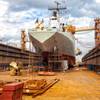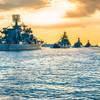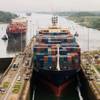Online Marine Camera Gives Underwater Views
For those who are curious about the undersea world but don't want to plunge beneath the waves, there is a safe and dry way to enjoy Neptune's realm.
Images of the stunning marine life around the Aliwal Shoal off South Africa's east coast are being beamed onto the Internet for a virtual dive safari via an underwater camera attached to the wreck of a Norwegian ship.
The web site can be found on www.africam.com - a site that also offers "virtual safaris" through cameras set up in several South African game parks.
"This is the first marine camera of its kind...It gives us an eye on the world that we've never had before," said Mark Addison, a diver responsible for the camera's maintenance.
The camera was set up initially last September in "the Cathedral", a spectacular amphitheatre-like hole in the reef which is a favorite resting place for ragged-tooth sharks.
Raggies - known as sand tigers in the U.S. and grey nurse sharks in Australia - spend the winter months of July to November breeding around the shoal.
They achieve sexual maturity at seven, when they generally reach a length of 7 ft.(2.2 m).
"You can see up to 30 sharks at one time in the Cathedral in an area the size of a squash court - it is truly an amazing sight," said Addison.
"The initial idea was to use the camera to study the sharks and their behavior around the clock." In November, the camera was pulled from the cathedral - it will be returned there when the sharks return - and placed on the wreck of the Produce in early February. The Produce, a bulk Norwegian merchant carrier of 13,058 tons, sand on the shoal five km (three miles) offshore in August 1974 while bound for Britain with a load of molasses. It broke in two.
No lives were lost and many of the survivors were plucked from the sea by the local fishing community.
The camera has been attached to a tripod that rests on one of the ship's deck rails at a depth of about 82 ft. (25 m).
It has picked up plenty of images from the shoal, which lies south of the port city of Durban on South Africa's Indian Ocean coast.
The rich marine life around the wreck - which has created its own little ecosystem by providing fish with protection - includes huge brindle bass, moray eels and a stunning variety of colorful tropical fish.
"The camera on the Produce has picked up a shark and the odd turtle," said Ferdi Oosthuizen, a diver who regularly changes the camera's batteries.
The images captured by the camera's 8mm lens are transmitted through an insulated cord to a buoy on the surface, which in turn transmits the images to a base system on land.
The still pictures transmitted to the web are refreshed every 30 seconds.
Addison said the advantages of examining a marine ecosystem 24 hours a day are obvious when compared to the short period of time that divers can spend under the sea.
Recreational divers who explore the wreck of the Produce can have their few seconds of fame by posing in front of the camera.
"The whole project is really great fun," Addison said. -(Reuters)













